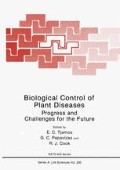Abstract
Phytophthora citrophthora (Smith and Smith) Leon. causes gummosis, foot and collar rot of trees, and brown rot of fruits in citrus areas in Turkey. Gummosis is very frequent especially in all citrus growing areas, and is the most important disease of lemon besides mal secco. Gummosis mainly affects the bark of trunks, and the main symptom is the formation of dark colored gum on the surface of the bark and cambium. The decayed bark shrinks, cracks and shreds as it dries out, and gum exudes from the cracks. Callus tissues are often developed in the bark to restrict further spread. The extent of lesions depends on the citrus species and on climatic conditions. In extreme cases, the tree is killed. The causal agent also infects fruit, resulting in a firm, light brown decay. Fruits near the ground become infected when splashed with the soil containing zoospores of the fungus. The pathogen attacks the plants under special cultural conditions, particularly during frequent heavy irrigations or prolonged periods of rainy weather.
Access this chapter
Tax calculation will be finalised at checkout
Purchases are for personal use only
Preview
Unable to display preview. Download preview PDF.
Literature Cited
Domsch, K. H., Gams, W., and Anderson, T., 1980, Compendium of Soil Fungi, Vol. I., Academic Press, New York.
Elad, Y., Chet, I., and Katan, J., 1980, Trichoderma harzianum: A biocontrol agent effective against Sclerotium rolfsii and Rhizoctonia solani, Phytopathology, 70: 119.
Gear, A., 1984, Trichoderma Newsletter. No. 1, H.D. Research Association, Essex.
Gear, A., 1985, Trichoderma Newsletter. No. 2, H. D. Research Association, Essex.
Gear, A., 1986, Trichoderma Newsletter. No. 3, H. D. Research Association, Essex.
Gear, A., 1988, Trichoderma Newsletter. No. 4, H. D. Research Association, Essex.
Papavizas, G. C., 1985, Trichoderma and Gliocladium: Biology, ecology, potential for biocontrol, Annu. Rev. Phytopathol., 23: 23.
Author information
Authors and Affiliations
Editor information
Editors and Affiliations
Rights and permissions
Copyright information
© 1992 Springer Science+Business Media New York
About this chapter
Cite this chapter
Bicici, M., Dede, Y., Çinar, A. (1992). Trichoderma Species Against Gummosis Disease in Lemon Trees. In: Tjamos, E.C., Papavizas, G.C., Cook, R.J. (eds) Biological Control of Plant Diseases. NATO ASI Series, vol 230. Springer, Boston, MA. https://doi.org/10.1007/978-1-4757-9468-7_25
Download citation
DOI: https://doi.org/10.1007/978-1-4757-9468-7_25
Publisher Name: Springer, Boston, MA
Print ISBN: 978-1-4757-9470-0
Online ISBN: 978-1-4757-9468-7
eBook Packages: Springer Book Archive

